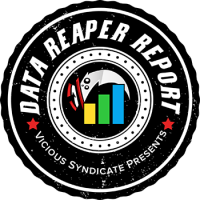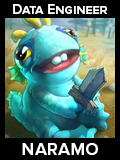
Welcome to the 88th edition of the Data Reaper Report! This is the first report of The Witchwood meta.
Our Data Reaper Project, including the Data Reaper Live has 3,100 active contributors and we thank them wholeheartedly. Contributing to the Data Reaper project through either Track-o-Bot or Hearthstone Decktracker (recommended) allows us to perform our analyses and to issue the weekly reports. Without the community’s contribution, there would be no project. Contributing data is very easy and takes a few simple steps, after which no other action is required. If you enjoy our content, and would like to make sure it remains consistent and free- Sign Up!
Quick Links
Class/Archetype Distribution | Class Frequency | Matchup Winrates | vS Power Rankings | vS Meta Score | Class Analysis & Decklists | Meta Breaker of the Week | How to Contribute | Credits
Number of Games
| Overall | 130,000 |
| Legend | 32,000 |
| Ranks 1-4 | 46,000 |
| Ranks 5-9 | 34,000 |
| Ranks 10-14 | 13,000 |
Class/Archetype Distribution
[TABS_PRO id=13310]
Class Frequency
[TABS_PRO id=13311]
Class Frequency Discussion
We should know by now. Valeera always finds a way. Despite being given a set of cards centered on the Burgle mechanic, she does not care. The class has steadily climbed in popularity since the expansion’s launch, taking over the top spot at legend, where it is far more popular compared to lower skill levels. Four different archetypes make up the class’ numbers: Odd, Tempo, Miracle and Quest. Odd and Quest Rogue are the dominant archetypes for the class, with Quest Rogue being the biggest comeback story of this expansion. The archetype is hardly even noticeable outside of higher levels of play, but when it comes to the top level, it is extremely influential on the meta. You’ll see that later on.
As expected, Warlock is a very dominant class in the WW meta. Cube Warlock is the most popular deck in the game from rank 10 onwards. Control and Zoo Warlock have a much smaller presence, and their builds are far less refined in comparison to Cube, an archetype that was figured out relatively early in the expansion’s life. During the writing of this report, Control Warlock was actually in a midst of another significant shift in its builds. We will be thoroughly discussing it in next week’s report, once we are able to evaluate these developments.
Notice that in this data set, we’ve managed to split Cube and Control Warlock apart. This was impossible to do in a reliable fashion during K&C. Aggressive decks in the WW got a little slower, and the two archetypes have slightly more noticeable early game patterns. After rigorous work and a lot of testing, we’ve determined it was possible to split them without skewing their matchup data. This wasn’t easy, and we will constantly monitor potential recognition issues (we always do, for all archetypes), as well as accommodate changes in the card usage patterns of these archetypes going forward.
Paladin is one of the most popular classes in the game. That’s not a surprise. What is a surprise is that we have a meta Paladin deck that doesn’t play Call to Arms and runs a bunch of arena cards! Odd Paladin has taken the meta by storm in the early days of the expansion, and remains the most popular class archetype at lower skill levels. However, we see a different picture at legend, where Even Paladin is the dominant strategy, and Murloc Paladin’s presence is also more noticeable. Last week, we’ve hinted at these two archetypes’ potential dominance of the field, and at higher levels of play, that call has been heard loud and clear.
Druid is the confused class of the early WW days and Taunt Druid is responsible for the erratic behavior we can observe in the daily timeline. The archetype has exploded into the scene after multiple players have achieved great success with it, but after hitting a peak, it rapidly declined once again. As always, the legend meta is ahead on the news, where the class is beginning to fade away from the top 3. Spiteful Druid, on the other hand, has shown greater consistency in its presence at all levels of play.
Mage was a middle-of-the-road class in K&C, and it seems to be sitting in that spot once again for the WW. Tempo Mage, which has lost some of its secret synergy, is the most prevalent archetype after increasing in play recently. Big-Spell Mage is headed in an opposite direction when it comes to its popularity. Elemental Mage has seen a lot of experimentation and play at lower skill levels, but doesn’t seem to have made any mark beyond that.
The WW expansion saw Priest taking the biggest hit in terms of its standing. From being the most popular class in the game boasting multiple powerful strategies, it is now sitting at a very modest spot. Spiteful Priest is the most popular archetype outside of legend, but it drops off quite a bit at legend, where it is eclipsed by Control Priest. Meanwhile, Combo Priest is an absolute mess of a cluster. Players have been throwing pretty much every shell possible at the wall of Divine Spirit and Inner Fire, hoping something sticks. We will likely have to wait at least another week for the archetype to flesh out before we can draw any conclusions regarding its power level or matchup data, so it will be missing from the power rankings table this week.
Has Hunter returned to its old ways? The most popular class in the game on day 1 of the expansion, sporting 18% of the field, Hunter has rapidly declined to the 7th spot. The new reincarnation of Face Hunter, powered by Baku, was all the rage when packs were being opened, but the enthusiasm seems to have died down. The other noticeable archetype for the class is Spell Hunter, now having to play fair without Barnes. Hunter is also seeing experiments with various Midrange builds as well as Big Kathrena Hunter decks, but they are hard to evaluate at this stage due to low prevalence.
Warrior is trying pretty much everything it can to stay relevant. From Control Warrior decks running Baku, to Taunt Warrior decks running Baku, to Taunt Warrior decks not running Baku. Fans of the class are trying to solve the weakness of Warrior’s late game power and its ability to match up to the powerhouses of the meta. In addition, experiments are being done with Rush Warrior, which has received the most support in the WW class set, but much like the other three archetypes mentioned, it hasn’t gained much traction.
Shaman joins Hunter in the Fake News department, after similarly crashing in its prevalence after the first day of the expansion, where Shudderwock Shaman received much attention and fame. The archetype is still the most popular Shaman deck at lower levels of play, but at legend, players have moved away from it and have attempted to build Midrange Shaman decks that utilize the legendary as a value bomb rather than a combo piece, and Even Shaman decks running Genn Greymane.
[TABS_PRO id=13312]

[TABS_PRO id=13313]
vS Meta Score
[TABS_PRO id=13314]
vS Power Rankings Discussion
New cards, new strategies, and Murloc Paladin sits at the top of the win rate charts once again. Word of the archetype’s dominance against the field has yet to spread to most of the player base, but Murloc Paladin is continuing to climb in popularity and the reason becomes clear: it wins a lot of Hearthstone games.
The Paladin archetype that is not a secret to anyone is Even Paladin. The deck is just very powerful and considering the various approaches and experiments it has gone through over the past week, its performance against the field is very impressive. Odd Paladin pales in comparison to the aforementioned two since it is less resilient to board clears and its comeback mechanics without Call to Arms are weaker. The Warlock matchup is also important: While all Paladin archetypes struggle dealing with the defensive tools available to Warlock, Murloc and Even Paladin stand a better chance, especially with the right tech.
Warlock is not going anywhere, especially when we consider the power level of Paladin and how imperative it is going to be to try and beat that class. Cube Warlock sits firmly at Tier 1, though its win rate has been on a steady decline as the rest of the meta caught up in terms of refinement and started targeting Cube with a lot of tech. There are many decks in the game that run two silences and two forms of weapon destruction, and that has certainly taken its toll on Cube. Even so, Cube Warlock is one of the best decks in the game, and we don’t see that changing considering the likely upcoming meta shifts. Control Warlock may look considerably weaker, but its win rate is low due to some poorly performing experiments dragging it down. It’s currently in the process of “cleaning up” and is improving its win rate on a daily basis, so we wouldn’t be surprised if it catches up with the upper half of the table. Its biggest advantage: it’s a stronger counter than Cube to Paladins of all types. Its biggest flaw: Lack of proactivity and kill potential makes it easier to punish. Quest Rogue is a massive issue for Control Warlock in particular.
Rogue is in a great spot, with four different archetypes that boast competitive win rates. After taking the field by storm at higher levels of play, Quest Rogue has begun to warp the meta at legend, encouraging the appearance of its counters, which has resulted in a drop in its win rate at legend. This deck will likely continue to shape the top level field going forward. If you examine this table and wonder why any particular control deck seems to be underperforming at legend ranks, the answer will usually be “Quest Rogue”.
Another impressive Rogue archetype is the aggressive Odd Rogue. After evaluating its builds, we’ve reached a firm conclusion that its new variants perform significantly better than the early variants. This means Odd Rogue has plenty of room for improvement in its win rate, and it could end up joining the elite group at the top of the win rate charts. Tempo Rogue is in a similar spot where it will likely become stronger after its refinement phase, but it may suffer from redundancy. If Odd Rogue continues to look like a superior option with a somewhat similar playstyle, Tempo Rogue could lose its niche in the meta and fade away despite carrying a strong win rate. Finally, Miracle Rogue is the last competitive Rogue deck, and it’s definitely a viable option, but it’s unlikely to grow in popularity since it is overshadowed by Quest Rogue, the more ruthless control counter.
Spiteful Druid has maintained a consistent win rate. It is particularly powerful at lower skill levels, where it’s looking even stronger than the Paladin decks, but its linear style of play makes us wonder about its future at the elite group. We know from experience that Spiteful decks carry a low skill ceiling, and that translates into a win rate decline at higher levels of play as time goes on, so that’s something to monitor going forward. Taunt Druid, on the other hand, has seen a meteoric rise followed by an epic crash in its win rate. Its win condition is powerful, but so slow that once the deck was anticipated by the field, it was heavily punished and countered. Paladin players realized there is no Spreading Plague to play around, while the abuse Taunt Druid has received at the hands of Quest Rogue at legend was not pretty (20-80 matchup).
Can control decks produce consistently good results under the shadow of Quest Rogue? One archetype is showing up to be a beacon of hope for late game strategies – Control Priest. Despite its poor matchup against Quest Rogue, it has one unique trait that can be observed in the matchup table. It is the only archetype in the game capable of beating both Paladins and Warlocks consistently. What this means is that if you ever run into a meta of Paladins and Warlocks trying to counter Paladins, Control Priest is an incredible choice to take advantage of the situation. Moreover, its primary weakness other than Quest Rogue is the Druid class, which is currently in decline. Things might be looking up for Priest if Quest Rogue is kept in check.
Around the middle in popularity, around the middle in win rate. This is the story for Mage so far in WW. Not too bad, not too great. Big-Spell Mage is actually a pretty strong choice during the legend climb, but falls off at legend, and you should already know the reason why. In contrast, Tempo Mage is one of Quest Rogue’s biggest counters and has a decent matchup spread overall including strong win rates against Warlocks, with its primary weakness being swarming Paladins once again.
Face Hunter is one of the worst performing decks in the game and doesn’t merit the play rate that it has, even after its huge decline over the past week. Strangely, we think it might have a spot in competitive tournament line ups that look to target Warlock and Quest Rogue, since these matchups are pretty much the only reason to play the deck. They might also carry Face Hunter to high legend win streaks once in a while. If you’re looking to hit people in the face and win games consistently, there are better options. If you really want to play Hunter, then Spell Hunter is certainly strong enough to do well with.
Warrior has a few surprises. The first one is that Control Warrior looks like a real Hearthstone deck. Yes, it seems to be scratching Tier 3, barely making it at legend, but when we consider the potential rise of the Paladin class, and Control Warrior’s ability to match up well enough against Cube Warlock with some ruthless tech, the archetype definitely has a chance. The second surprise is that Taunt Warrior is the best performing Warrior archetype. Not the Baku version, but the normal version. Its ability to run Warpath and Blood Razor makes it a nightmare for Paladin decks to deal with, and it’s a very strong counter to aggressive decks in general. Taunt Warrior falls over to control decks, but not enough to push it off a surprisingly good ladder win rate. We think it’s a sleeper tournament deck that can fit well in anti-aggro line ups.
Has Shaman also found a way back into competitive viability? It may have, but the keys to the castle don’t seem to rest at the claws of Shudderwock, but at the hands of Genn Greymane. Even Shaman looks like an archetype with good potential and scope for improvement. It’s a great choice to queue into Paladins, Druids and Rogues of all kinds. Its biggest stumbling block is the Warlock matchups, which are absolutely horrible, and push the archetype’s win rate below 50%, but it maintains a respectable win rate that’s far better than what Shaman was used to during K&C.
Any sleeper decks running under the radar, you ask? There are some, starting with the elephant in the room that is Zoo Warlock. Despite being ignored and barely receiving attention, Zoo’s win rate suggests it still has a place in the WW meta. As for archetypes that don’t appear in the power rankings due to low play rates, there is one we’re quite interested in: Token Druid looks promising to us and definitely merits more exploration. If you’re interested in trying it out, Muzzy’s list is featured in this report.
Class Analysis & Decklists
Druid | Hunter | Mage | Paladin | Priest | Rogue | Shaman | Warlock | Warrior
The Witchwood didn’t look like an exciting expansion for Rogue, as very few of the new Rogue cards stood out as good options for any Rogue decks. In the initial experimentation phase players tested Tess Greymane, together with Blinkfox and Hallucination in Miracle Rogue and Tempo Rogue lists. This quickly fell flat as Rogue decks resorted to their old ways of focusing on more reliable win conditions.
The most recent scourge of high level ladder play has definitely been Quest Rogue. Rising in play in order to counter slow decks such as Taunt Druid, the archetype has seen consistent success at high legend ranks over the past week. Rage reached #1 legend with a list that includes Valeera the Hollow and Sap, which are strong techs against slower decks. An alternative build path was taken by Surrender to #1 legend, running the Fire Fly/Igneous Elemental package in order to add consistency to the completion of the quest, as well as two copies of Fan of Knives, which is a Paladin tech. When playing Quest Rogue, be mindful of whether the opponents you’re queuing into merit the inclusion of removal spells, with Backstab also being a viable option.
Casie’s Miracle Rogue build, which has seen success by multiple players at high legend ranks, returns to an old favorite in Questing Adventurer in order to beat up on the slower decks in the meta. It also includes one new WW card, Hench-Clan Thug, which has become a staple inclusion in multiple Rogue archetypes. Over time, the archetype has struggled to find relevance with the rise of Quest Rogue, a much more ruthless counter to slower decks.
Another successful archetype that was born at the launch of Witchwood is Odd Rogue, taking Baku and the upgraded hero power to new aggressive heights, alongside Rogue’s new best friend, Hench-Clan Thug. The Odd Rogue builds started off hyper aggressive, with cards such as Kobold Apprentice seeing play to fight off Paladins. Over time, Odd Rogue has slowed down to accommodate 5 drops. Xixo’s and Glaser’s builds are good representatives of this development, which has had a very positive effect on Odd Rogue’s win rate.
Much like Miracle Rogue was pushed out by Quest Rogue, Tempo Rogue could face a similar fate as the result of Odd Rogue’s success. The Prince Keleseth-centered archetype peaked with Arreador reaching #2 legend with Gyong’s list, but hasn’t seen much success and attention since.
The standard meta is only beginning to develop in the scant few days since the set has been released, but since day 1, Cube Warlock has fulfilled the prophecy of staying on top. It is the most popular deck in the game and it continues to be the deck of choice if you’re interested in a strong all-around deck that’s not particularly weak to any prevalent strategy. It’s not a deck without weaknesses, since it can definitely suffer as a result of tech hate, and it doesn’t have the staying power that it used to thanks to the loss of N’Zoth, but the combination of strong defensive tools alongside a threatening win condition that relentlessly beats down opponents is still a very successful one.
While some tinkering is made with the archetype, Cube Warlock has not fully embraced any of the new cards from The Witchwood. Lord Godfrey shows up here and there, but isn’t a staple by any means, and the same could be said for Voodoo Doll. The main debate when it comes to Cube Warlock is whether or not to play Mountain Giants. Fire hit #2 legend by running the standard Cube list with Giants and Taldaram at the 3 slot. This is the most well-rounded build that takes into account mirror match ups as well as the rising Quest Rogue. Consider Lord Godfrey as an optional tech card against Paladins.
Control Warlock is still around, albeit in smaller numbers. Zuhex’s #10 legend build packs Ooze, Gnomeferatus and Rin for the mirror matchup. Plated Beetle helps contest aggressive openings. Early results indicate the obvious conclusion: if your meta is packed with aggro, defensive Warlock decks with fewer combo pieces are going to perform better.
When it comes to Zoo Warlock, we are faced with an archetype that has barely begun its development. There are many experiments being done with Zoo, but most of them have proven to be quite weak so far. For now, simplicity seems to work best for the archetype, by running a set of good standalone cards instead of more situational synergies. Our featured build is an example of sticking to the basics. Should a different list pop up and prove its consistency over time, it will get our attention.
The transition to the Year of the Raven has been very good to Paladin thus far. Even and Odd Paladin lists have hit top legend ranks with consistency, and continue to post dominant performances in the current meta. Murloc Paladin has also reared its head and proven to be very powerful against the field.
Odd Paladin was the first Paladin archetype out of the gates, with players such as Gallon and Aojiru hitting #1 legend on the back of unrelenting snowballing board states. As the deck continued to go through refinements, it cut some of the “fat” to produce a build that looks to maximize the efficiency of its power turns, leading to the iteration featured in the report. While Ironbeak Owl is a tech consideration in order to improve your matchup against Warlocks, it might be smarter to just change decks if you’re queuing into them often.
Even Paladin bloomed later on, but has proven to be more resilient and difficult to counter, and it’s arguably the strongest deck in the format at the moment. So many of the power cards available to Paladin are of even cost, that the condition is not a big sacrifice to meet. The archetype has proven to be able to deal with Warlocks better than Odd Paladin, with the introduction of lists running double Ooze, double Spellbreaker and double Avenging Wrath, as exhibited in Tyler’s top 10 legend build (later on, he experimented with running Dinosize over Silver Sword). Newer iterations cut 8-drops for Saronite Chain Gangs, with Orange including Val’anyr at the top end of his list. It’s likely that Even Paladin’s late game options will continue to be a source of experimentation
Murloc Paladin has seen a renaissance in recent days, with multiple players having success piloting BoarControl’s build. With the loss of key 1-drops in Grimscale Chum and Vilefin Inquisitor, Rockpool Hunter is not as strong as before rotation, leading to the deck having less explosive starts. However, Nightmare Amalgam is a fantastic 3-drop for the archetype, curving right into Gentle Megasaur and giving the deck a beefier mid-game. The concern over the early game consistency remains, with Fenom having success at high legend ranks with a list running Argent Squires at the 1.
After a dismal showing in the Kobolds & Catacombs expansion, Malfurion has climbed his way back to the top half of the play rate charts. Spiteful Druid and Taunt Druid are the two main archetypes that are pushing Druid’s play rates. However, both of these archetypes carry question marks that make us wonder how good can they be once the meta settles down.
Spiteful Druid leads the charge for the class as both the most popular and highest win rate archetype. Prince Fancy’s build, which we’ve mentioned in our article last week, is a strong standard build for the archetype that’s easy to pick up and do relatively well with.
Taunt Druid is the new archetype in town, taking advantage of the interaction between Witching Hour and Hadronox in order to grind out opponents in the late game. Numerous builds have been experimented with over the past week, leading to a few conclusions. The first is that two UI’s are clunky, as the second copy often ends up sitting dead in your hand since the deck plays out slowly and doesn’t have the ability to dump its hand efficiently like Jade Druid used to. The second conclusion is that Oakheart is an amazing card in the deck, often leading to blow out victories. It’s worth maximizing Oakheart by running a single copy of Dragonhatcher to pull out a Primordial Drake on the same turn. The third is that teching against Cube Warlock is important. Harrison Jones and Naturalize allow you to deny your opponent from cubing a Doomguard, which is Cube Warlock’s strongest line of play against you.
Other Druid archetypes have yet to make their mark on the meta, with several experimentations being done. Token Druid builds utilizing Wispering Woods are the most intriguing ones we’ve seen so far, and it will likely take a bit more time to assess whether these efforts can lead to consistent results. Muzzy’s Sea Giant list is a good start.
Mage has taken a hit in popularity after the release of the new expansion. New Mage archetypes have not really established themselves so far. Rather, Big-Spell Mage has slightly changed from its K&C counterpart, while Tempo Mage has also adopted a few additions to make up for the lost secret synergy cards. Elemental Mage has failed to take off in any direction, so we will keep a wait-and-see approach regarding this archetype.
Lifedrinker and Cindestorm are two cards that found a home in Tempo Mage. Lifedrinker is a versatile minion that’s useful in both control and aggressive matchups, while Cinderstorm turned out to be a surprisingly strong card in the deck, since it can act as both a removal tool and burn to face. Its little brother, Arcane Missiles, has also made it into the deck for the same reason. Apxvoid and CitizenNappa hit high legend ranks with similar builds, only differing in two cards. Apxvoid runs a Fire Fly, which helps contest early board, as well as Bloodmage Thalnos to synergize with your missile cards. CitizenNappa opts for Arcane Keysmith, a flexible 4-drop that might end up being a useful card in both slow and fast Mage archetypes.
Big-Spell Mage’s gameplan remains the same as it was before. It tries to control the board with numerous board wipes and then outlast the enemy with Frost Lich Jaina. Arcane Keysmith is a great addition because its flexibility is particularly powerful in a reactive deck, and it allows you to “run” secrets without interfering with Dragon’s Fury. The ability to generate an Ice Barrier or a Vaporize can help make up for the loss of Ice Block. Witchwood Piper guarantees drawing you an Arcane Artificer, which is one of your best cards against aggressive decks. Voodoo Doll could well be a Mage card, since the class’ hero power makes it a guaranteed removal tool against any minion, even a Tyrantus off a Spiteful Summoner, and the Doll has further upside post-Frost Lich Jaina that cannot be underestimated.
Oh how the mighty have fallen. At least for now, Priest isn’t the juggernaut it’s been for the last 8 months or so. The class didn’t get any clear game changing cards, yet lost a ton of extremely strong tools, so it’s most likely not close to being fully fleshed out for this meta.
When new expansions come out, it becomes obvious which cards are extremely strong, and decks are built around them way before sleeper decks can be discovered beyond the obvious cream of the crop. Often, players will continue trying to use decks from past metas, which is why Spiteful Priest is seeing the majority of Priest play. One thing we’ve noticed is that current variants of Spiteful Priest continue to run Free from Amber. With the buff to random 10-drops summoned by Spiteful Summoner, we think it might be worth testing a list that only runs Mind Control in order to guarantee that 10-drop.
Despite being the most popular Priest deck overall, Spiteful Priest may not be the strongest option available to the class. At the moment, Control Priest is charting as the strongest of the current Priest decks, with Theo’s #1 legend build setting the standards for the archetype. The deck looked extremely powerful at one early point in the expansion’s life, but is one of the victims of the rise of Quest Rogue at legend ranks. With burst through Mind Blast as its late game win condition, weapon tech and a plethora of board wipes, it is the only deck in the game capable of performing well against both Paladins and Warlocks, which would have established it as a surefire Meta Breaker if not for Quest Rogue.
Combo Priest was one of the strongest decks around during the era of K&C, but it is struggling to find its feet at the moment, with several experiments going haywire and pushing Combo Priest’s win rate far down. However, there is a decent chance that a strong build can be found, take over and change the fortune of the archetype. A list we’re curious to see flesh out was piloted to #2 legend by Affie. This build runs Unpowered Steambots as combo targets as well as Witchwood Pipes to fish out Clerics, which are your primary card draw engines. Meati slightly altered the build to take top 25 legend on two different servers, running a bigger taunt package with Tortollan Shellraiser.
In a meta where Paladins are dominating other aggressive strategies while Warlocks are defining how the late game plays out, Hunter has struggled to find a place. Players have persisted in their attempts of refining Odd Face Hunter builds as well as revamped versions of Spell Hunter, in order to try and carve out a niche for the class in the current meta.
Face Hunter has been transformed under Baku, now limited to running odd cost cards for the intimidating timer set by the upgraded Ballista Shot. Hunter has a set of decent core cards that fit the build, especially at the 3-slot. Most of the debate takes place in the 1-drop slot, where there is some variation. Londgrem’s #1 legend build includes 1-drops that focus on board control, in Fire Fly and Argent Squire. These minions apply less immediate pressure on the opponent’s life total but stick to the board better. Rookie’s #1 legend build runs Leper Gnomes and Emerald Reavers, with a clear purpose of maximizing your damage output as quickly as possible. The archetype is a pretty strong counter to slower Warlocks and Quest Rogue, which might help it carve out a narrow niche at top legend ranks as a counter queue deck, but Face Hunter has a massive issue dealing with most other strategies in the current meta.
The other somewhat major Hunter deck is Spell Hunter, which players have attempted to continue running after the passing of Barnes. Builds utilize To My Side and Rhok’delar now that they consistently hit their condition, but Spell Hunter is undoubtedly weaker than before the rotation. No longer are players able to just cheese a win through a turn 4 play which has little to do with actual Hearthstone games, and instead are forced to always deal with their opponent’s threats. To that end, Spell Hunters have started teching in Grievous Bites to stand a better chance against the slew of Paladins on ladder. NickChipper’s list gives a good example of the standard Spell Hunter list, which shouldn’t see too much variation, considering the limited pool of Hunter spells.
It’s an odd time to be a Warrior player. After much experimentation at salvaging the class from its lethargic state before the rotation, results have been lukewarm. A promising avenue for the class appears to be a Control Warrior deck running Baku and tanking up every turn, much like in the days of Justicar Trueheart. Furyhunter hit #1 legend with a build that’s fully teched out. Two forms of weapon destruction, two silences and Big Game Hunter occupy slots in order to make Cube Warlocks sweat. In addition, a rush package with Town Crier, Rabid Worgen and Darius Crowley is included and helps contest aggressive openings. This deck looks to grind out opponents and mostly fatigue them to death, with some value included in the form of Elise the Trailblazer to force the issue earlier.
Odd-Taunt Warrior has also adopted Baku and looks to tank up before switching gears and hitting your opponent with Rag shots. Phantom Militia is a particularly strong addition that significantly increases the consistency of your quest completion. Kyouma and LambySeries have had high legend success recently with their variants of the archetype, but overall, Odd-Taunt’s performance against the field is horrendously poor. It is actually normal Taunt Warrior, without Baku, which is performing better against the field at the moment, and we feature an example list.
Finally, the most pushed archetype for the class in the Witchwood has certainly been Rush Warrior. A tempo Warrior deck disabling your opponent’s initiative by generating immediate value trades sounds sweet on paper, but so far, this archetype has not panned out well. One exception is Kibler’s Rush Warrior deck which runs Countess Ashmore and Scourgelord Garrosh. We think there might be potential in this list, since it’s very effective against board-centric aggressive decks.
A new day shines on all of us Shaman players, or does it?
Right off the bat, Shaman garnered much attention with the Shudderwock Combo deck that Disguised Toast popularized on his stream. The deck aims to utilize multiple key Battlecry triggers that will culminate with creating multiple triggers of Lifedrinker in a single turn. The deck immediately gained notoriety as the turn of the Shaman player can reportedly reach up to 5 minutes. Since then however, the deck’s popularity went down as players realized that the deck isn’t very good. Even with all the AOEs and heals available to it, it’s very soft against aggression of any kind. While things could change with innovation, don’t hold your breath.
After the combo experiments, players have attempted to slot Shudderwock in a deck that just runs it for the sheer value it brings rather than executing an OTK. Ender hit #7 legend with a Midrange list that aims to play out a tempo focused game while utilizing the late game bombs of Hagatha, Kalimos and Shudderwock at its top end.
Another archetype that appeared on our radar this week is Even Shaman. This might be the strongest deck available to Shaman that could propel the class to competitive viability. Cocosasa has peaked at #15 legend running a Corpsetaker list with Sea Giants. The deck is essentially a “good-stuff” midrange curve deck. It features the strongest minions at each mana slot available to the class, and is topped off by Hagatha the Witch, an excellent value generator for a minion focused deck.
The first few shots have been fired and the meta is centering on the interactions between Paladin, Warlock and Rogue, which are the three most influential classes in the game.
Paladin dominates the board like no other, which means it holds the initiative, and defines the early game meta. In order to beat Paladins, you have to carry multiple board swing tools and constantly wear it down. We think that Call to Arms is the single best card in the game.
Warlock counters board centric decks because it has the best AOE tools in the game and cheats out big minions faster than opponents can handle. Cube Warlock is the most well-round and flexible deck in the format, and the one that’s most difficult to consistently counter. You can make it bleed, but you cannot make it go away.
Rogue dominates late game because its late game is reached on turn 7, and on turn 8, Quest Rogue is already about to kill you. No other deck can match the power of Quest Rogue once it completes its quest, which is why it defines the late game meta. Go for the throat when facing Quest Rogue, or find yourself bitten.
We’ll see you next week.
Our Data Reaper Project, including the Data Reaper Live has 3,100 active contributors. Without them, this project would not be possible, so we’d like to thank all of our contributors for their help.
Preparing our weekly article requires a significant amount of time and effort from many individuals. We would like to wholeheartedly thank our current Patreons, whose generous donations help us fund computing and server costs.
vS Gold is a new membership plan aimed to support our efforts towards improving our content and data analysis while receiving some bonuses and extra features.
Tier 3+ Patrons
Special thanks to Leo G, Chungfr, Kognar, Aaron B, Jed M, Drew M, Alan J, Eric L, Jeffee83, Zolstar, Pink Mage Diaries, Eric H, Lim E, Sean H, asHram, Andrew N, NObdy, Mark S, Andrew, Alonso P, msKang, and Andrew R for supporting us for the month of April.
A HUGE thank you to our Tier 5 Patron(s): ByteCookie!
Contributors
Here are all the people that participated in bringing you this edition of the vS Data Reaper Report:































Looks like the adventures of garrosh and thrall will keep up with them as the worst classes in the game
Garosh is fine… He has a proper legend viable Tier 2 Taunt Warrior (the one without Baku)
Thrall stays where he was though and gets a new roommate (Rexxar)